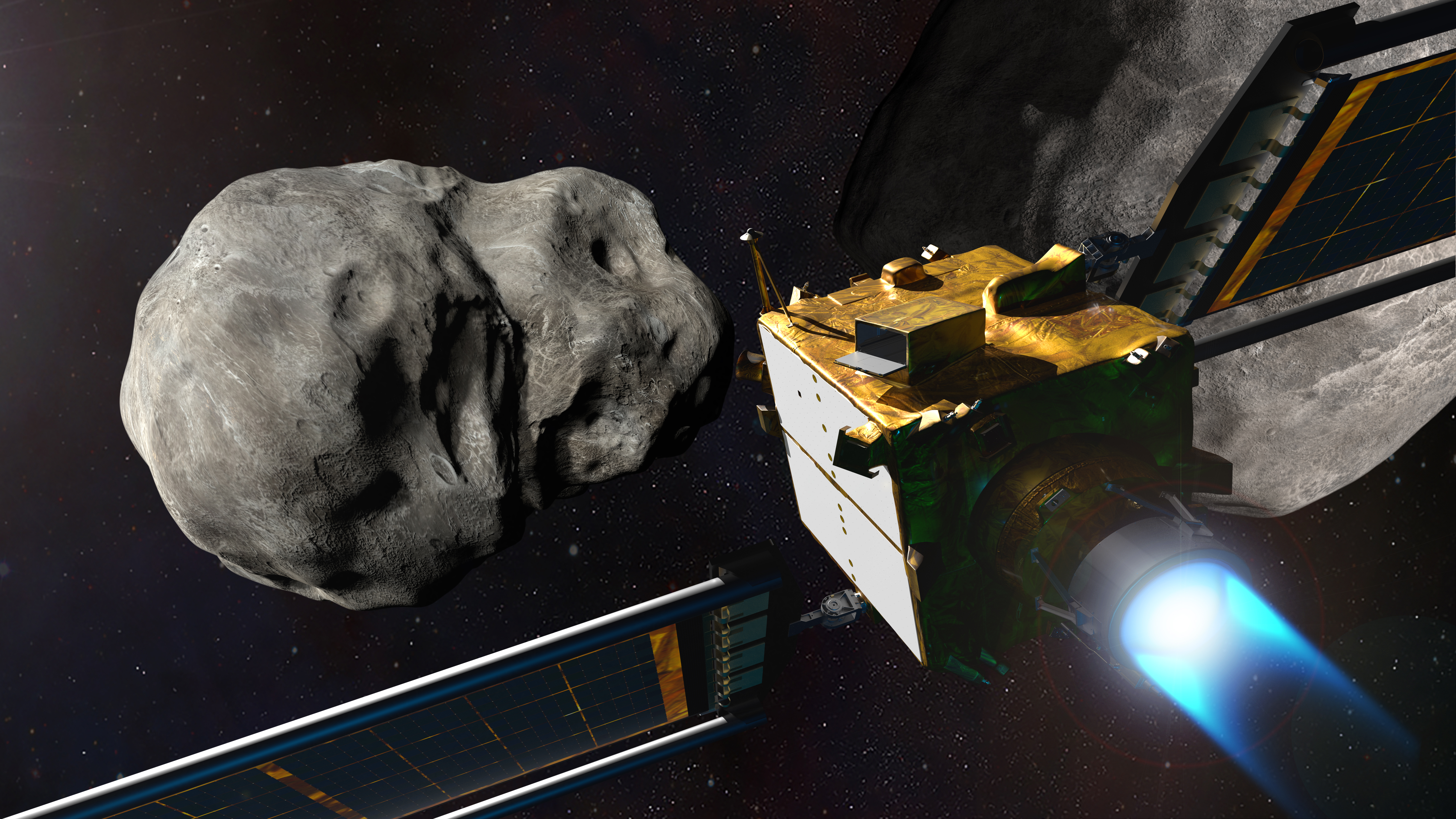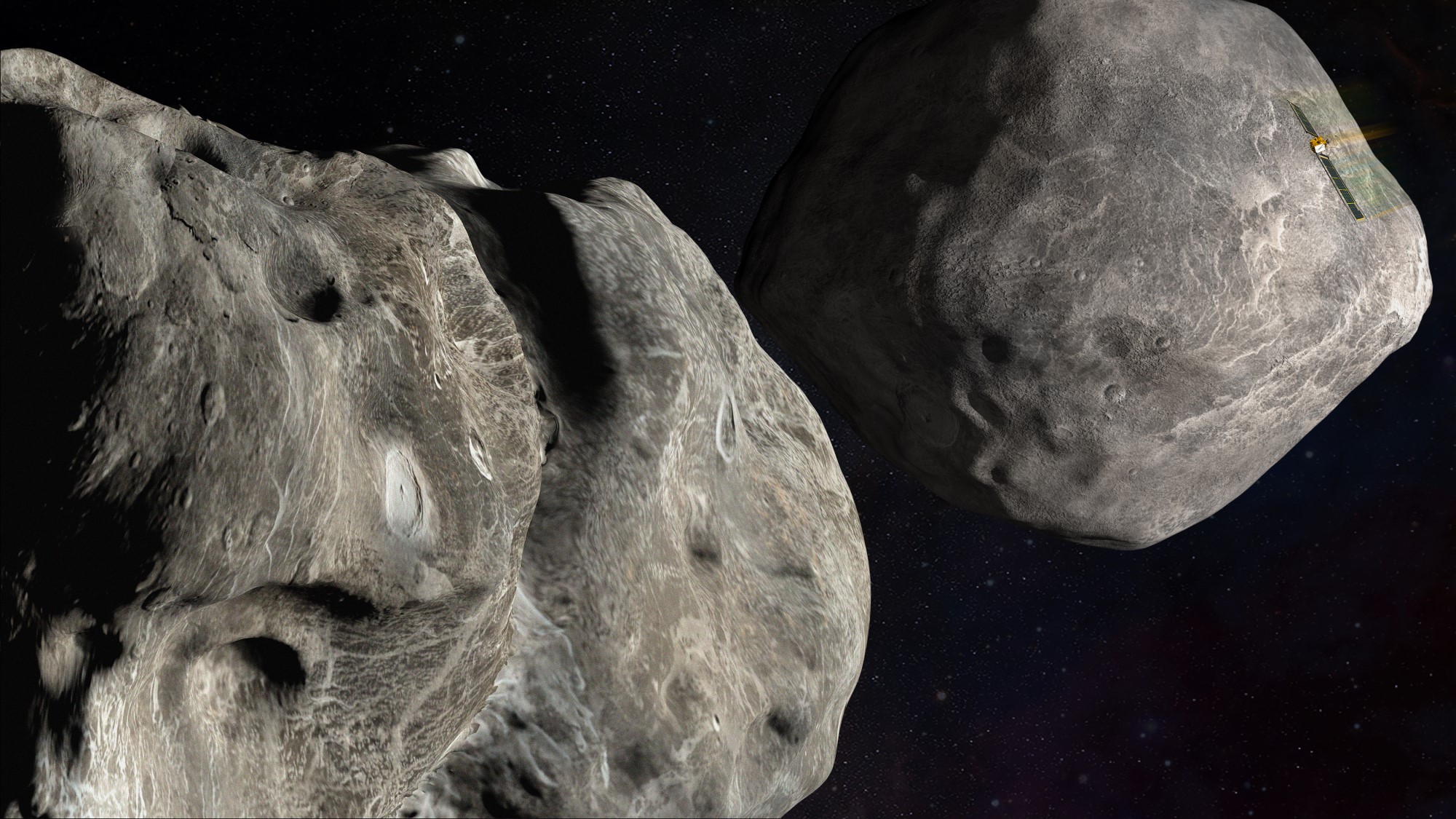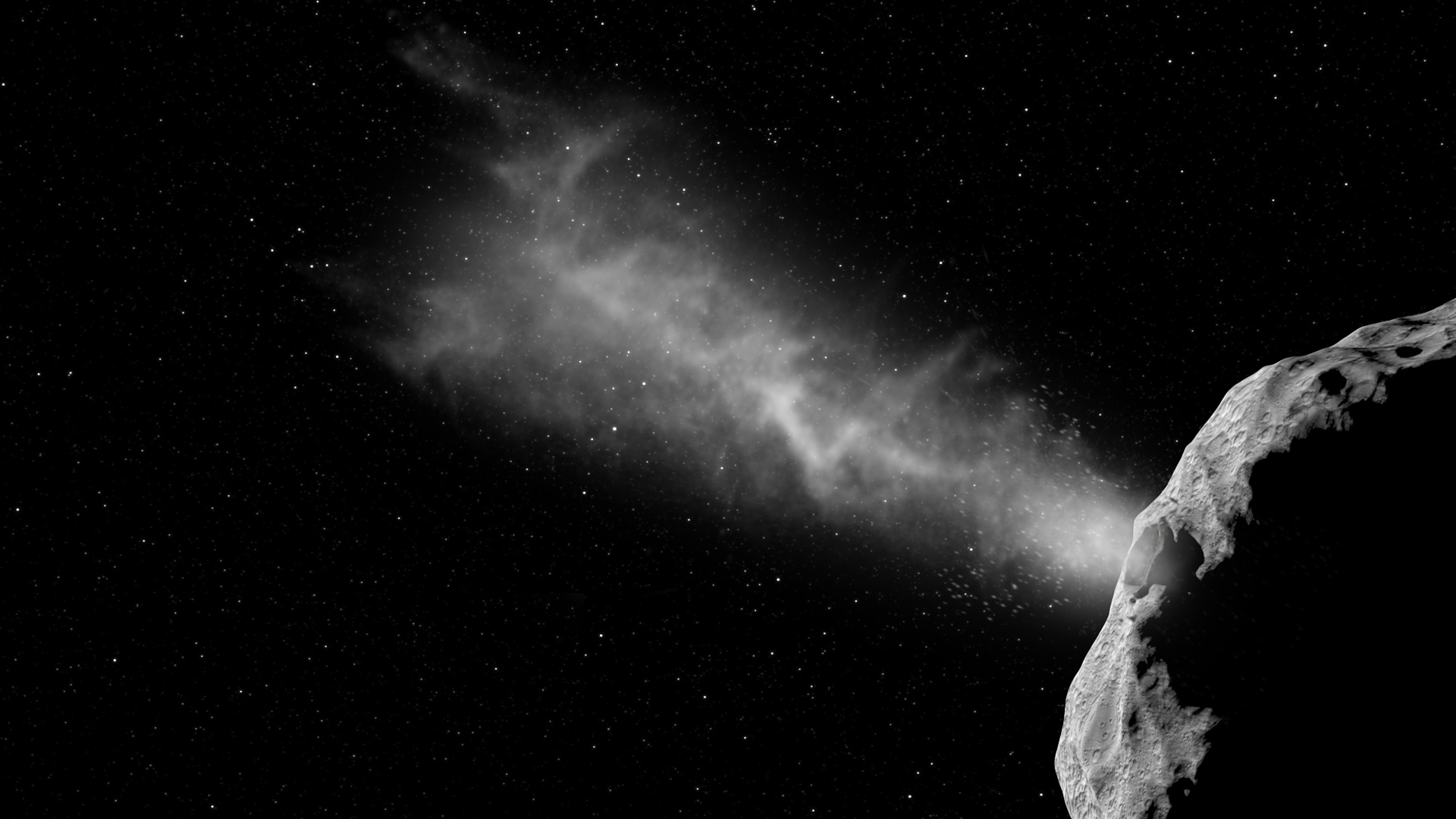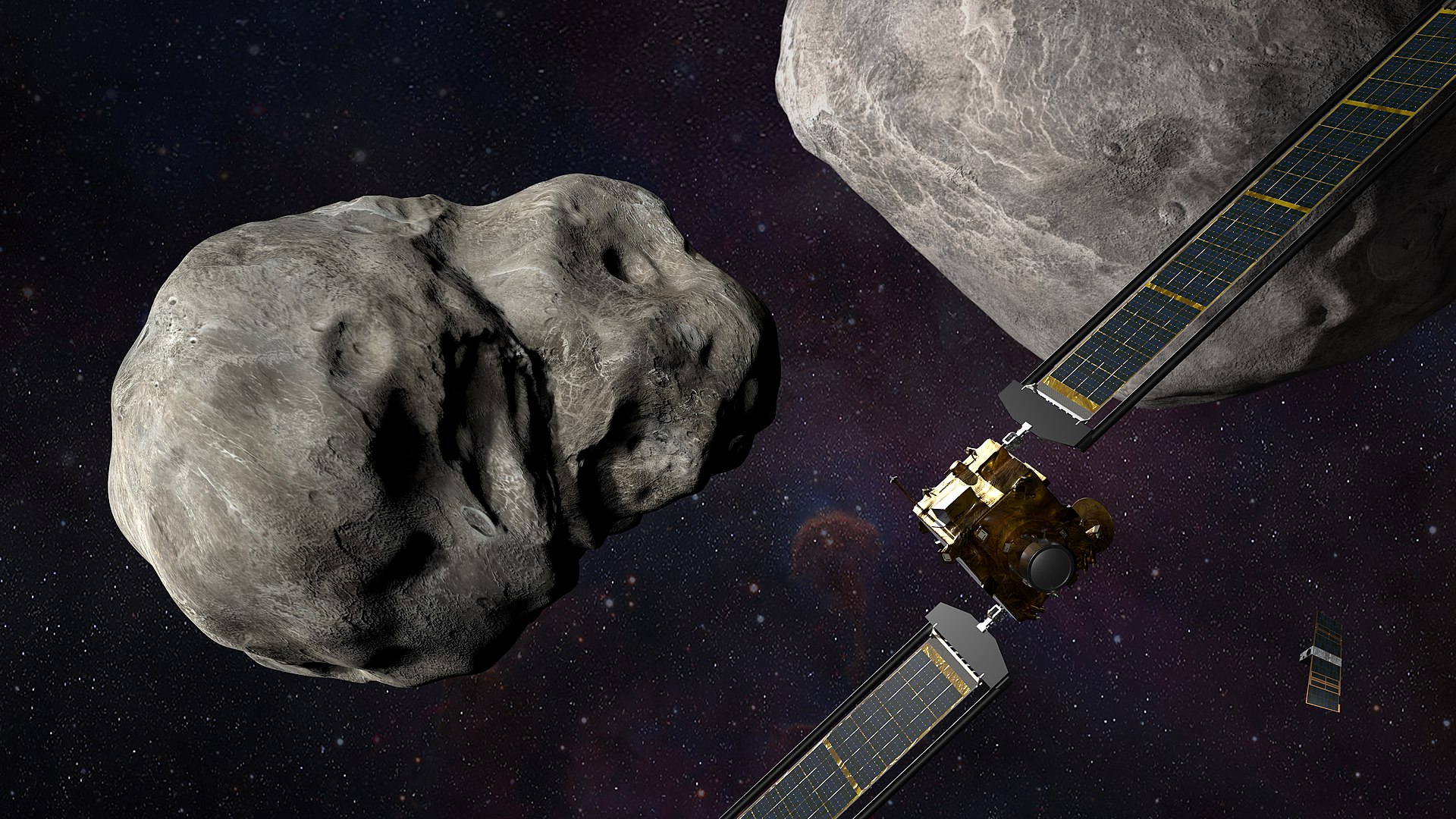DART asteroid crash: What time will NASA probe hit Dimorphos on Sept. 26?
NASA's DART spacecraft will crash into the asteroid Dimorphos on Sept. 26 at 7:14 p.m. EDT. Here's how the day will unfold.
- Sept. 25: One day to impact
- Sept. 26: 4 pm ET - Terminal phase begins
- 5:30 pm ET: 1st DART asteroid views
- 6 pm ET — NASA DART webcast begins
- 6:34 pm ET: 50 minutes before impact
- 6:54 p.m. ET — DART precision lock
- 7:11 p.m. EDT — DART cuts its engines
- Sept. 26: 7:14 p.m. ET — DART impacts asteroid Dimorphos
- 7:17 pm ET — LICIACube flies past Dimorphos
- 8 p.m. ET — DART post-impact briefing
A NASA spacecraft will soon make history when it crashes into an asteroid in the world's first planetary defense test.
The Double Asteroid Redirection Test, or DART asteroid mission, will slam a spacecraft into the tiny moon of the asteroid Didymos on Monday, Sept. 26, with the impact set at 7:14 p.m. EDT (2314 GMT). If all goes well, the spacecraft will hit the moonlet, called Dimorphos, and snap images until the moment of impact. You'll be able to see those images live in real time. Read on for a handy guide on when it will all happen.
But first, some science. NASA's DART mission launched nearly a year ago on Nov. 24, 2021 to test the use of a "kinetic impactor" to change the orbit of an asteroid — the first planetary defense test of its kind.
Related: 8 ways to stop an asteroid: Nuclear weapons and Bruce Willis?
DART's target Dimorphos is about 560 feet (170 meters) wide and orbits its larger parent Didymos once every 11 hours and 55 minutes. The asteroids are about 7 million miles (9.6 million kilometers) from Earth and pose no risk of impacting our planet, NASA has said. DART should hit Dimorphos while traveling at about 14,760 mph (23,760 kph). Here's what DART's last day will be like.
Sunday, Sept. 25: One day to DART asteroid impact
While the stage was set for NASA's DART asteroid impact with its launch in 2021, the space rock impact action really starts to heat up in the final 24 hours. That's when DART will perform its final maneuver to set it on course for a Didymos impact.
"After the final maneuver on Sept. 25, approximately 24 hours before impact, the navigation team will know the position of the target Dimorphos within 2 kilometers [1.2 miles]," NASA officials wrote in a statement. "From there, DART will be on its own to autonomously guide itself to its collision with the asteroid moonlet."
Get the Space.com Newsletter
Breaking space news, the latest updates on rocket launches, skywatching events and more!
Related: Why did NASA pick Didymos for its asteroid-crash mission?
Monday, Sept. 26: 4 pm ET — DART terminal phase begins

About four hours before impact, the DART spacecraft will enter what mission scientists call its "terminal phase." The spacecraft's DRACO camera should be locked on the Didymos asteroid and looking for its moon Dimorphos.
"At that point, at four hours, we are actually targeting Didymos because we can't see Dimorphos," said Evan Smith, DART's deputy mission systems engineer at the Johns Hopkins University Applied Physics Laboratory (JHUAPL) in Laurel, Maryland.
During the terminal phase, DART's flight controllers will no longer be issuing ground commands. The spacecraft will be fully on autonomous targeting using its smart navigation system, Smith said.
Monday, Sept. 26: 5:30 pm ET — DART asteroid camera views
At 5:30 p.m. EDT (2130 GMT), NASA will start broadcasting a real-time stream of photos from DART's Draco camera. This is the camera that will show the asteroids Didymos and Dimorphos as they grow larger in DART's field of view.
"In the hours before impact, the screen will appear mostly black, with a single point of light. That point is the binary asteroid system Didymos, which is made up of a larger asteroid named Didymos and a smaller asteroid that orbits around it called Dimorphos," NASA wrote in a video description.
The images in this stream will be delayed slightly because of the time it takes the signal to reach Earth from DART 7 million miles (11 million km) away, then be processed on the ground. NASA has already released one view of Didymos from DART, as well as a view of Jupiter and its moons.
"After impact, the feed will turn black — due to a loss of signal. After about 2 minutes, this stream will turn into a replay — showing the final moments leading up to impact," NASA wrote.
Monday, Sept. 26: 6 pm ET — NASA DART webcast begins
NASA's live webcast of the DART asteroid impact will begin on Monday at 6 p.m. EDT (2200 GMT).
NASA has said it is this stream that will have the raw, most up-to-date images of the asteroid impact as it happens. The webcast will be run out of JHUAPL, which oversees the mission for NASA.
Sept. 26: 6:24 pm ET — 50 minutes before impact

About 50 minutes before DART hits Dimorphos, the spacecraft should shift its targeting to the smaller moonlet at last.
"At 50 minutes to impact, we'll have been seeing Dimorphos for maybe 40 minutes," Smith said, adding that both the moonlet and its parent Didymos should be in the spacecraft's camera view. "Both objects will still be in the field of view, but we're going to go straight for Dimorphos and go for impact on there."
Sept. 26: 6:54 p.m. ET — DART precision lock on Dimorphos
At 6:54 p.m. EDT (2254 GMT), DART will be just 20 minutes from crashing into Dimorphos and its smart navigation system will enter what is called "precision lock."
"At 20 minutes before impact, we're going to something called precision lock, in which we totally ignore Didymos and we go straight for Dimorphos only," Smith said. "We expect to be thrusting quite a bit at that period."
Sept. 26: 7:11 p.m. EDT — DART cuts its engines

Just after 7:11 p.m. EDT (2311 GMT), DART will cut its 12 hydrazine thrusters and prepare for the inevitable. The spacecraft will then be on track to crash into Dimorphos at 14,760 mph (23,760 kph).
"At two-and-a-half minutes before impact, we cut off all thrusting, and we're going to coast in," Smith said. "We're going to be streaming images the whole time. "
Sept. 26: 7:14 p.m. ET — DART impacts asteroid Dimorphos

This is it, the big moment! If DART hits it mark, this is when the live views of Dimorphos from the DRACO camera will cut out.
Elena Adams, DART's lead mission systems engineer at JHUAPL, said there is a 91% to 99% chance of a successful impact if DART's cameras can see Dimorphos.
The impact should kick up a huge plume of ejecta that a small cubesat called LICIACube should see. The cubesat hitched a ride with DART during launch and was ejected a few weeks ago.
Sept. 26: 7:17 pm ET — LICIACube flies past Dimorphos

Three minutes after DART hits Dimorphos LICIACube should fly by the impact site.
LICIACube will snap photos of the resulting ejecta plume created by DART's crash and then send them back to Earth. The images will likely be released on Sept. 28, as it takes time for the small cubesat to beam them back, NASA has said.
LICIACube (short for "Light Italian Cubesat for Imaging Asteroids") was built by the Italian Space Agency and was released by DART on Sept. 11.
"We expect to receive the first full-frame images and to process them a couple of days after DART’s impact," Simone Pirrotta, LICIACube project manager for the Italian Space Agency, said in a statement.
Sept. 26: 8 p.m. ET — NASA DART post-impact briefing
At 8 p.m. EDT (0000 GMT on Sept. 27), NASA will hold a press conference to discuss the DART asteroid impact.
While we don't have a list of who is attending the press conference, you can be sure it will be filled with mission managers and JHUAPL and NASA officials hoping to celebrate DART's success. The press conference will be webcast live on NASA TV.
You can watch the press briefing on our DART asteroid impact webcasts page.
And that's a look at what time DART will crash into the asteroid Dimorphos and how the day will unfold.
Visit Space.com on Monday, Sept. 26, for complete coverage of NASA's DART asteroid mission.
Email Tariq Malik at tmalik@space.com or follow him @tariqjmalik. Follow us @Spacedotcom, Facebook and Instagram.
Join our Space Forums to keep talking space on the latest missions, night sky and more! And if you have a news tip, correction or comment, let us know at: community@space.com.

Tariq is the Editor-in-Chief of Space.com and joined the team in 2001, first as an intern and staff writer, and later as an editor. He covers human spaceflight, exploration and space science, as well as skywatching and entertainment. He became Space.com's Managing Editor in 2009 and Editor-in-Chief in 2019. Before joining Space.com, Tariq was a staff reporter for The Los Angeles Times covering education and city beats in La Habra, Fullerton and Huntington Beach. In October 2022, Tariq received the Harry Kolcum Award for excellence in space reporting from the National Space Club Florida Committee. He is also an Eagle Scout (yes, he has the Space Exploration merit badge) and went to Space Camp four times as a kid and a fifth time as an adult. He has journalism degrees from the University of Southern California and New York University. You can find Tariq at Space.com and as the co-host to the This Week In Space podcast with space historian Rod Pyle on the TWiT network. To see his latest project, you can follow Tariq on Twitter @tariqjmalik.









